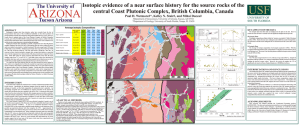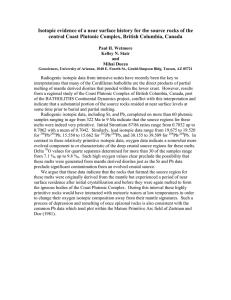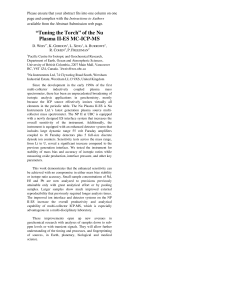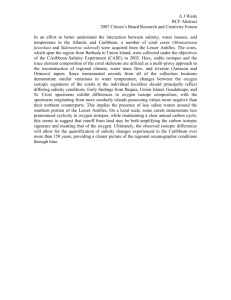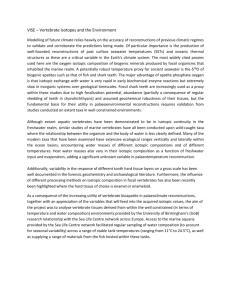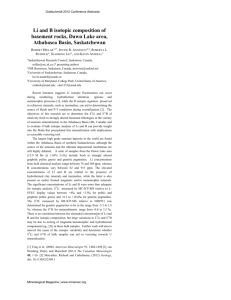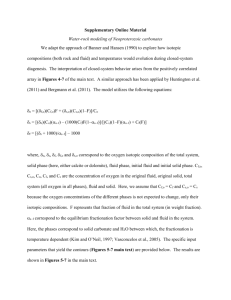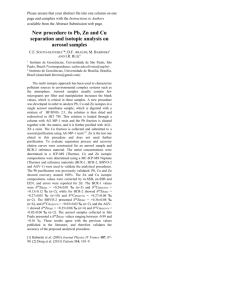Document 10565997
advertisement
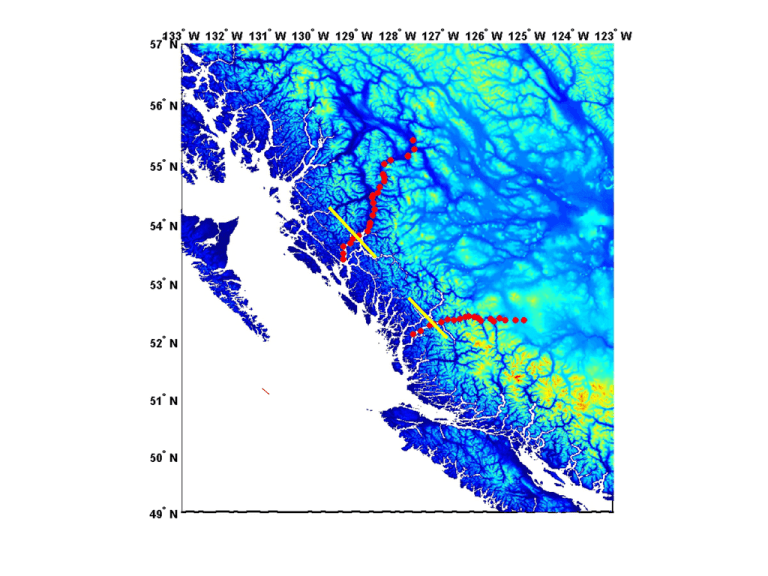
0 Δ Ray Path ΔΔ Δ Δ Δ ΔΔ Δ Δ Δ Δ Δ Δ Depth (km) 20 40 60 80 100 −150 −100 −50 0 Distance (km) 50 100 150 CSZ CSZ BS06 BS04 BS09 BS07 BS10 BS11 BS13 BS15 BS12 BS14 BS17 BS16 BS19 BS18 BS22 0 20 depth (km) 40 60 80 100 CSZ 50 100 150 y offset (km) 200 Evt.60.baz.148.del.39.F.0.05.0.4 BN23 0.8 BN22 0.6 BN21 0.4 BN20 0.2 0 BN19 0 20 Time (s) 40 60 BN17 BN15 4 BN14 2 BN13 0 BN09 −2 −4 BN18 BN16 6 Median Trace Shifted traces Station Median Envelope 1 BN04 0 20 Time (s) 40 60 20 30 40 Time (s) Evt.111.baz.345.del.87.F.0.05.0.4 BN23 55.4 55.2 BN20 BN19 55 Latitude 55.6 BN22 BN21 54.8 54.6 54.4 54.2 residual (s) 54 53.8 53.6 −129.5 55.2 0.3 0.2 0.1 0 −0.1 BN18 BN17 BN16 BN15 BN14 BN13 BN23 55.4 BN20 BN19 55 Latitude 55.6 BN22 BN21 0.04 BN18 BN17 BN16 BN15 BN14 BN13 54.8 54.6 54.4 0.02 0 −0.02 −0.04 errors (s) 54.2 54 53.8 BN04 −129 −128.5 Longitude −128 −127.5 53.6 −129.5 BN04 −129 −128.5 Longitude −128 −127.5 Evt.119.baz.22.del.47.F.0.05.0.4 55.2 BN20 BN19 55 BN22 BN21 54.6 54.4 0.2 0 54.2 54 53.8 53.6 −129.5 55.2 BN20 BN19 55 BN18 BN17 BN16 BN15 BN14 BN13 54.8 BN23 55.4 54.6 54.4 residual (s) 54.2 0.04 0.02 0 −0.02 −0.04 errors (s) BN18 BN17 BN16 BN15 BN14 BN13 54.8 −0.2 BN22 BN21 54 53.8 BN04 −129 −128.5 Longitude −128 −127.5 53.6 −129.5 BN04 −129 −128.5 Longitude −128 −127.5 errors (s) BN23 55.4 Latitude 55.6 Latitude 55.6 Evt.89.baz.221.del.92.F.0.05.0.4 BN23 55.4 55.2 BN20 BN19 55 Latitude 55.6 BN22 BN21 54.6 54.4 0.2 0 −0.2 residual (s) 54.2 54 53.8 53.6 −129.5 55.2 BN20 BN19 55 BN18 BN17 BN16 BN15 BN14 BN13 54.8 BN23 55.4 Latitude 55.6 BN22 BN21 BN18 BN17 BN16 BN15 BN14 BN13 54.8 54.6 54.4 0.05 0 −0.05 54.2 errors (s) 54 53.8 BN04 −129 −128.5 Longitude −128 −127.5 53.6 −129.5 BN04 −129 −128.5 Longitude −128 −127.5 Evt.60.baz.148.del.39.F.0.05.0.4 55.2 BN20 BN19 Latitude 55 54.6 54.4 54.2 0.1 0 54.6 −0.1 54.4 residual (s) 54.2 −128 −127.5 53.6 −129.5 BN22 BN21 0.02 BN18 BN17 BN16 BN15 BN14 BN13 54.8 53.8 −128.5 Longitude BN20 BN19 0 −0.02 errors (s) BN09 54 BN04 −129 55.2 55 BN09 54 53.6 −129.5 BN22 BN21 BN18 BN17 BN16 BN15 BN14 BN13 54.8 BN23 55.4 BN04 −129 −128.5 Longitude −128 −127.5 errors (s) BN23 55.4 53.8 55.6 Latitude 55.6 Subduction zone structure in Cascadia data, seismicity and tomographic velocities. To complicate matters further, Preston et al. (2003) proposed that the shallow-most (<45 km) Benioff events in Cascadia, such as those beneath western Vancouver Island, may actually lie within the Juan de Fuca plate mantle (the result of serpentine dehydration) rather than within the subducted crust, as previously assumed. Consequently, seismicity constraints on the position of the plate may need to be reconsidered. The utility of seismicity in precisely locating the plate is also compromised by location errors, although approaches such as double differencing (Waldhauser & Ellsworth 2000), arrival pattern location (Nicholson et al. 2002) and 3-D empirical traveltimes (Nicholson et al. 2004) have recently improved location accuracy. Resolution of the debate concerning the position of the subducted crust is of central importance in resolving important geodynamic questions (Rogers & Dragert 2003). Despite uncertainty surrounding the location of the downgoing plate, much has been learned about the geometry and character of the E-reflectors (Clowes & Hyndman 2002). The reflectors form a thin (<2 km) zone off the coast of central Vancouver Island (Calvert et al. 1996; Nedimovic et al. 2003) but thicken to 12–15 km off the coast of southern Vancouver Island (Calvert et al. 2003) and appear to be 5 to 8 km thick inland of the western coast of Vancouver Island (Green et al. 1986; Nedimovic et al. 2003). It is unclear at what depth the E-reflection zone terminates. Nedimovic et al. (2003) interpret the E-reflectors to end abruptly where the bottom of the zone encounters the forearc mantle, at a depth of 33 ± 3 km. Calvert et al. (2003), on the other hand, demonstrate that the E-reflectors persist to a depth of at least 50 km. Part of this disagreement could be explained by differences in transect position. Kurtz et al. (1986) used magnetotelluric data to show that the E-layer is highly conductive across most of Vancouver Island. The E-layer and C-layer (a second, weaker, shallower zone) are also thought to possess low density (e.g. Clowes et al. 1997) and low P-wave velocity (e.g. Drew & Clowes 1990), although it should be noted that recent tomographic models do not clearly demonstrate this latter property (Ramachandran 2001; Preston et al. 2003). Receiver function studies have shown that the C-layer is less prominent than the underlying E-layer and that both are low-S-velocity zones. There have been several explanations proposed to explain the high reflectivity and low S-wave velocity of the E-layer as well as the observation that it extends to mantle depths. These include interpreting the E-layer as: (1) the top of the subducting Juan de Fuca plate (Green et al. 1986), although this interpretation is now largely discounted; (2) interlayered mafic and/or sedimentary rocks (Yorath et al. 1985; Clowes et al. 1987); (3) intensely sheared sediments that trap fluids released from the subducting plate (Calvert & Clowes 1990); (4) thin dipping fluid-filled lenses of high porosity, with fluid supplied by dehydration reactions within the underlying oceanic plate (Hyndman 1988). It has also been proposed (e.g. Nedimovic et al. 2003; Calvert 2004) that the E-reflectors may represent a zone of ongoing deformation associated with the slow slip events observed along the Cascadia subduction zone (Rogers & Dragert 2003) with a welldefined 14-month periodicity. 3 D AT A A N D P R O C E S S I N G In the period 2002 April–2002 November, 26 broad-band seismometers were deployed by the POLARIS consortium across the northern C 2005 RAS, GJI, 161, 849–859 851 Figure 2. Distribution of broad-band, three-component POLARIS-BC stations over northern Cascadia (red and white triangles). Red triangles indicate stations used in Section 4.1. The dashed line shows the 2-D profile used in Section 5, while the dotted region extending from PFB in the west to DURW in the east shows the region of seismicity used in Fig. 8. Figure 3. Distribution of events with sufficiently high signal-to-noise ratio. The region west of the array is well covered, along with central and southern America. Note that this distribution is reasonably good for a global teleseismic study. Cascadia subduction zone to supplement five permanent broad-band stations operated by the Geological Survey of Canada (see Fig. 2). Together these 31 stations form the POLARIS-BC array—an approximately linear array spanning southern Vancouver Island, the Strait of Georgia, coastal Washington and the British Columbia Fraser Valley. The array operated until 2004 December. As of 2004 January, 71 teleseismic events of magnitude 6.0 or greater and with high signal-to-noise ratio had been recorded by the POLARIS-BC stations (see Fig. 3). Azimuthal coverage is relatively good since almost the entire Pacific, central and South America lie within the range of teleseismic P (30◦ –100◦ ). The azimuthal coverage is poor only to the south and northeast of the study region. Subduction zone structure in Cascadia 853 Figure 5. (a) Source-normalized scattered S waves for all the data used in the multistation neighbourhood inversion. (b) Synthetic scattered S waves generated using the best-fit model (see Table 1). Stations are ordered by position along the profile, with western stations first. Note that the main features of the data are well reproduced by the synthetics. Also note that the correlated signal fades to the east of SSI. Table 1. Model parameters for best-fit plate model across Vancouver Island. Parameters for layers 1–3, 5 and 7 are held fixed in the inversion, as is the P velocity and density for all layers. Layer Thickness (km) V P (m s−1 ) V S (m s−1 ) ρ (kg m−3 ) Strike Dip 1 2 3 4 5 6 7 8 9 1.0 5.0 1.0 4.0 11.0 4.5 3.0 5.0 90.0 5000 6000 6700 6350 7100 6350 7750 6800 7750 2890 3460 3870 3790 4100 2990 4470 4280 4470 2800 2800 2930 2800 3140 2800 3030 2880 3200 0 0 0 0 0 0 −48 9 0 0 −48 16.5 0 0 −48 17 0 0 region (Calvert et al. 1996; Nedimovic et al. 2003). Owing to the use of data from an array of stations, the strike (N48◦ E) is likely to be better constrained than that determined from previous singlestation receiver function analysis. The S-wave velocity contrasts, of C 2005 RAS, GJI, 161, 849–859 1.1 km s−1 at the top and 1.45 km s−1 at the bottom of the E-layer, are consistent with the results of Frederiksen et al. (2003), although they are larger than those proposed by Cassidy (1995). The other two low-velocity layers (C and F) are significantly weaker than the E-layer. In particular, we note that the F-layer arises from the presence of slightly larger-amplitude signals within the E-layer P-s-s window than expected (see Fig. 5), implying interference with an F-layer P-p-s phase. There is little or no visual indication of an F-layer P-s-s phase arriving at later times, and removing the layer entirely only changes the fit to the data by a small amount (less than 1 per cent), consistent with the results of Frederiksen et al. (2003). 4.2 Single-station inversions Inverting for the structure beneath individual stations allows the depth and material properties of layering to be determined locally near each station. Thus variations in V S and deviations from Friday Feb. 24 meeting agenda (10 minute presentations) 1. Let’s decide Friday and Sunday morning: a) student projects b) data sharing formats c) publications (active source time offset). 2. Ken: Neighborhood mapping of S-SKS posteriori probability density functions for 5 simplest anisotropy models from Billings array data 3. John: Grid search of Lodore array Pds signals to constrain velocity steps amplitude and sharpness 4. Steve: construction of minimum phase spectrally shaped Greens’ functions from teleseismic P coda. 5. Josh: Imaging of Yellowstone mid-crustal sill using seism, doubleseism, and infra-seismic ‘hum’ sources. 6. Arizona 1 7. Arizona 2 8. Arizona 3 Batholith natural source research sub-projects 1. Migration of p-sv-sh green fcts for image 2. SKS & S shear wave anisotropy (standard processing) 3. S and SKS shear wave anisotropy using NA PPD mapping and 5model testing. 4. P and S-wave teleseismic body wave tomography. 5. Modeling p-sv-sh azimuthal response for crustal anisotropy/dipping boundaries. 6. Surface waves: a) ‘In-line’ mostly broadside ballistic surface wave imaging. b) Surfaces waves imaging between the two lines c) Diffusive wave imaging between stations and lines. 7. local and regional moment tensor analysis for stress state. 8. regional wave crustal modelling 9. deep disconitinuity imaging for LAB, 410, 660, etc arrivals 10. construction of the master model (all results on SAME spatial overlay). 11. Inline Pn velocity analysis Data sharing formats (both: us and rest of group) 1. antelope dbase tables (north and south individual dbases and one-master dbase): site-sitechan-instrument-sensornetwork-wfdisc-arrival-assoc. CORRECT, (time dependent) sitechan table of orientations. 2. telesesimic travel-times (css3.0 residual table and a matlab matrix) 3. teleseismic tomography images (matlab matrix). 4. migrated p-sv-sh response (matlab matrix?) 5. anisotropy (add anisotropy table to css3.0 schema) Batholith experiment visit schedule 1. march-april 2. june-july 3. september-october (demobilization) Evt.111.baz.345.del.87.F.0.05.0.4 0.8 BN23 0.6 BN22 BN21 0.4 BN20 0.2 0 BN19 0 20 Time (s) 40 60 4 Median Trace Aligned traces Station Median Envelope 1 BN18 BN17 BN16 2 BN15 BN14 0 BN13 −2 −4 BN04 0 20 Time (s) 40 60 20 30 Time (s) 40 Evt.119.baz.22.del.47.F.0.05.0.4 BN23 1 BN22 BN21 0.5 0 BN20 BN19 0 20 Time (s) 40 60 3 BN18 BN17 BN16 2 Median Trace Aligned traces Station Median Envelope 1.5 BN15 1 BN14 0 −1 BN13 −2 BN04 −3 0 20 Time (s) 40 60 20 30 Time (s) 40 29 Figure 4. Comparison of VP and VP/VS for ACCRETE rock samples (Table 1) with seismic measurements (Figures 2a-b). Laboratory velocities were corrected for high crustal temperature under the CMB, using a temperature/pressure gradient of 0.8°C/MPa [Christensen, 1979]. Velocities between lithostatic pressures of 400 and 1000 MPa are shown, with filled symbols corresponding to 800 MPa and arrows pointing in the direction of increasing pressure and temperature. Note that high crustal temperature leads to velocities that are nearly constant or even Figure 3. Apatite He ages as function of elevation for three vertical profiles located in Figure 2, with 2 s uncertainties. Regression through Foch Mountains profile yields exhumation rate of 0.22 mm/ yr, consistent with other two profiles as well. Figure 2. Douglas Channel study area. Symbols denote sea-level sampling locations and apatite (U-Th)/He ages. Three vertical sampling profiles are labeled. Bearing of line A-A9 is N40E. basin subsidence (Hyndman and Hamilton, 1991; Rohr and Dietrich, 1991; Rohr and Currie, 1997). In the study area (Figs. 1 and 2), the Coast Mountains are composed of high-grade metamorphic rocks and Mesozoic and Tertiary plutons (Roddick, 1970). Samples for this study are tonalite and granodiorite with several metamorphosed granitoid rocks.1 A deep fjord, Douglas Channel, provides excellent rock exposure for sampling of the range both in the vertical and horizontal dimensions. It crosses the northwest trend of the Coast Mountains adjacent to the Queen Charlotte basin and so should reflect the effects of lithospheric-scale deformation proposed by Rohr and Currie (1997). We analyzed 33 samples from an ;85-km-long sea-level traverse to identify possible fault offsets, block tilting, and paleotopographic effects on He age patterns. In addition, 22 samples on 3 vertical transects were analyzed from the southwest, central, and northeast portions of the traverse (Mount Jenkinson, Foch Mountains, and Mount Elizabeth profiles, respectively, Fig. 2). These three profiles provide between 1 and 1.6 km of vertical coverage, each sampled over a few kilometers lateral distance. RESULTS Apatite He age data are reported in the Appendix (see footnote 1). He ages on the vertical transects range from 4.5 to 19.4 Ma and correlate strongly with sample elevation (Fig. 3). Over the ;1100 m from sea level to the summit of Mount Jenkinson, He ages increase from 7 to 11 Ma. The Foch Mountains transect is similar: He ages increase from 4.5 Ma at sea level to 11.6 Ma at 1400 m. At Mount 1GSA Data Repository item 200115, Appendix 1, Methods and data, is available on request from Documents Secretary, GSA, P.O. Box 9140, Boulder, CO 80301-9140, editing@geosociety.org, or at www.geosociety.org/ pubs/ft2001.htm. 100 Elizabeth, He ages increase from 5.7 Ma at 600 m to 9.5 Ma at 1450 m; above this elevation ages increase much more rapidly, to 19.4 Ma at 1800 m. A striking feature of these data is the linear age-elevation segment in all three transects. A regression line through the most complete profile (Foch Mountains) yields a slope of 0.22 6 0.01 mm/yr; this slope is very similar to those on the Mount Jenkinson (0.28 6 0.03) and lower segment of the Mount Elizabeth (0.24 6 0.03) profiles. Although they share essentially the same slope, the three profiles are shifted from each other, such that the He age found at sea level on Mount Jenkinson is found at ;500 m in the Foch Mountains and ;900 m at Mount Elizabeth. The vertical displacement between these profiles is similar to the relative mean elevation of the sampling locations, which for the Mount Jenkinson, Foch Mountains, and Mount Elizabeth regions increases from 401 m to 634 m to 1051 m. Sea-level apatites along Douglas Channel yield He ages that range from 2.8 to 14 Ma; the youngest ages are near the center of the traverse and the oldest ages are at the southwest end (Fig. 2). When projected onto a line crossing the range (A-A9, Figs. 2 and 4A), most He ages along the traverse define a shallow asymmetric v-shape. Except for two samples at the southwest end of the traverse, ages decline from ca. 9 Ma in the southwest to ca. 4 Ma at the center, then increase to ca. 5.5 Ma in the northeast. As in the vertical profiles, ages on the sea-level traverse correspond with local mean elevation (10 3 10 km grid) measured beside Douglas Channel: samples from regions of higher local mean elevation have lower He ages (Fig. 4B). The two anomalously old samples at the southwest end of the traverse are interpreted as the result of local faulting (Rusmore et al., 2000). INTERPRETATION Apatite He ages throughout this part of the Coast Mountains are young, requiring exhumation from temperatures of .70 8C since the middle Miocene. Based on a geothermal gradient of ;28 8C/km (Lewis et al., 1991; Parrish, 1983), this corresponds to at least 2.2 km of exhumation. The age-elevation profiles in Figure 3 document three distinct aspects of this exhumation history. The shallowly sloped portion of the Mount Elizabeth profile defines an exhumed He partial retention zone established during a period of approximate thermal stability from before 20 Ma to 10 Ma, during which exhumation was ,0.03 mm/yr. He age modeling (Wolf et al., 1998) indicates that the shallow slope GEOLOGY, February 2001 Figure 4. A: Sea-level He ages, projected on line A-A9 in Figure 2. Two circled samples are likely on single downthrown fault block, and were excluded from B. B: Position of 8 Ma He age surface (stepped line, dashed where inferred) compared to mean elevation (smooth curve). Age surface was constructed by interpolation from three vertical profiles (triangles) and extrapolation of observed sealevel ages using age-elevation slope of 0.22 mm/yr (open symbols). Mean elevations were computed in 10 3 10 km squares along length of profile using digital elevation model (DEM). Because DEM excludes all surfaces covered by seawater, mean elevations were computed for squares abutting Douglas Channel. Elevations of age surface were averaged in 10 km intervals to be compatible with averaging used on topography. of this profile is best fit by thermal stability extending to .30 Ma. The break in slope at ;1500 m elevation indicates the onset of more rapid exhumation at 10 Ma. After this time all three profiles document relatively slow and nearly constant exhumation of ;0.22 mm/yr. The data also indirectly define the more recent exhumation history. A 28 8C/km geothermal gradient and a local mean annual temperature of 6 8C (Environment Canada, 2000) imply that the apatite closure isotherm (68 8C, Farley, 2000, and Appendix [see footnote 1]) is located ;2.3 km below the Earth’s free cooling surface, or 1.9 km, 1.7 km, and 1.2 km below sea level at Mount Jenkinson, the Foch Mountains, and Mount Elizabeth, respectively. However, extrapolation of the age-elevation profiles in Figure 3 indicates that in the absence of a change in exhumation rate, the closure isotherm would be at ;1.4 km, 1.0 km, and 0.6 km below sea level at these sites. This discrepancy suggests enhanced recent exhumation of ;0.6 km. The timing of this increase is best defined at the Foch Mountains, where it must have occurred after 4 Ma. Compared to the exhumation rate from 10 to 4 Ma, the post-4 Ma rate is at least 70% higher (i.e., 0.37 mm/yr if the change occurred at 4 Ma, and greater if the change occurred later). While large changes in mean annual temperature may be erroneously interpreted as a change in exhumation rate (O’Sullivan and Brown, 1999), existing estimates of the degree of post-Miocene cooling in this region (Mathews and Rouse, 1963) are insufficient to account for the inferred 0.6 km. Unless the geothermal gradient is substantially higher than estimated, the data require a significant acceleration of exhumation after 4 Ma. The similarity of the three vertical profiles coupled with the smooth pattern of ages on the horizontal traverse indicate that the entire GEOLOGY, February 2001 Douglas Channel region underwent a broadly similar thermal history from 10 to ca. 4 Ma. Although there is abundant structural evidence for faulting in the area, some of which corresponds to deviations in the He age pattern (including the old ages at the southwest end of the traverse, Rusmore et al., 2000), the He ages in general limit localized post-10 Ma faulting in the region to less than a few hundred meters of vertical motion. As shown in Figure 4B, the elevation of contours of equal He age exhibit to ;1 km of long-wavelength relief that corresponds with local mean elevation. This observation is consistent with two alternative models of the geomorphic evolution of the Coast Mountains. Because near-surface isotherms will in general mimic topography, He ages of apatites exhumed through such a temperature field carry a record of topography present during cooling. A correlation between topography and He ages in the Sierra Nevada was interpreted by House et al. (1998) to be the record of long-wavelength paleotopography. If we apply this interpretation to the Coast Mountains, then the correspondence in Figure 4B documents the topographic expression of the Coast Mountains back to at least 10 Ma. Based on the present topographic wavelength along our traverse (;40 km), relief on the closure isotherm would be ;75% of the topographic relief (House et al., 1998), so the approximate correspondence in Figure 4B suggests relief similar to or slightly greater than at present. In other words, this interpretation requires the range to have looked essentially like it does today for the past 10 m.y. despite more than 2 km of exhumation and a major transition in climate and erosional style following the onset of continental glaciation ca. 3 Ma. Given the unambiguous evidence for intense glacial incision producing Douglas Channel and tributary fiords, such long-term geomorphic stasis seems implausible. Our preferred interpretation is that the range developed exclusively after 4 Ma. In this scenario, differential rock uplift after 4 Ma vertically deflected both the local Earth’s surface and originally near-horizontal He age marker horizons to yield the correlation observed in Figure 4. This hypothesis suggests a broad upwarp centered on the Foch Mountains region, and a second and larger uplifted region near Mount Elizabeth. The magnitude of post-4 Ma differential uplift and relief development implied by our results is ;1 km. This finding is compatible with the suggestion by Parrish (1983) that part of the relief in the southern Coast Mountains developed in the late Neogene. A significant corollary of this hypothesis is that long-wavelength topography across the range must have been small enough to maintain nearhorizontal isotherms prior to differential uplift. More specifically, the region must have had subdued long-wavelength relief (less than a few hundred meters with wavelength .20 km) across the 85 km investigated here, starting at 10 Ma and extending at least until Pliocene time. On the basis of palynologic and geomorphic studies of sites on the plateau east of the Coast Mountains, Rouse and Matthews (1979) and Matthews (1991) similarly inferred a lack of topographic barrier in middle Miocene time. DISCUSSION Apatite fission-track age-elevation profiles led Parrish (1983) and O’Sullivan and Parrish (1995) to propose two major episodes of exhumation in the southern Coast Mountains, one in the late Eocene (35– 40 Ma) and a second in the late Miocene (5–8 Ma) separated by a period of relative stability. The fission-track results are complicated by strong compositional effects on annealing kinetics, but the 30–5 Ma portion of this history is generally consistent with our He ages in the northern Coast Mountains. Parrish (1983) also proposed a late Miocene to Holocene period of exhumation; this may be equivalent to the enhanced post-4 Ma exhumation we propose for Douglas Channel. The exhumation history we document has implications for both 101 Isotopic evidence of a near surface history for the source rocks of the central Coast Plutonic Complex, British Columbia, Canada Paul H. Wetmore#*, Kelley N. Stair#, and Mihai Ducea# UNIVERSITY OF SOUTH FLORIDA #Department of Geosciences, University of Arizona, Tucson, AZ 85721 *Department of Geology, University of South Florida, Tampa, FL 33620 Western Early K 18.4 Western Jurassics GJP Pb 204 Pb isotopic compositions all plot within the “mature arc primitive” field of Zartman and Doe (1981). Ratios become more radiogenic and exhibit less scatter through time. The intrusions with the most radiogenic Pb are located nearest the Coast Shear Zone (CSZ). 17.8 17.0 17.5 18.0 18.5 206 Pb/204 Pb i 206 East 19.0 19.5 20.0 -100 20.5 -75 -50 -25 0 25 50 75 Distance from CSZ (km) Pb/ 204Pb 19.2 15.68 19.0 15.66 15.64 18.8 15.62 18.6 15.60 18.4 15.58 18.2 15.56 18.0 1 -8 15.54 West 17.8 East 100 150 200 -100 -75 -50 -25 0 25 50 75 Distance from CSZ O Isotopic data 80 PGJ 0.710 0.709 0.706 0.706 0.705 9 -7 7 PGJ GJP a 5 9. 7 M 87 5 1. l ana + Sr/ 86 Sr i 0.707 8 l ba West 0.703 East 0.702 0.702 0 25 50 75 100 125 150 175 -100 200 -80 -60 -40 7 -7 Ma GJP 0.7 + .6 Coast Shear Zone Intrusive Suite -20 0 20 40 60 INTERPRETATIONS AND CONCLUSIONS 80 Distance from CSZ Age (Ma) 55 Douglas Channel Transect Ecstall Intrusive Suite latest Early to earliest Late Cretaceous Intrusives 12 12 11 11 10 10 Kilometers 25 Paleozoic/Mesozoic Metasediments and Volcanics Coast Shear Zone T OR AF SE 7 7 6 6 -100 West 0 50 100 G 100.0 + 2.3 JP -4 0 Key Bella Bella -60 -40 -20 0 20 40 Distance from CSZ (Km) 18 G JP G JP 36 -3 5 G G JPJP 3 -3 3 4 Sr vs. d O 12 G JP -2 3 82.8 + 2.8 latest Paleocene and Eocene intrusives. Coast Shear Zone Intrusive Suite Eastern Late Cretaceous intrusives. 182.4 + 4.7 61.5 + 1.7 G JP -2 Ecstall Intrusive Suite DEA G JP -3 G JP -3 1 N CH AN N G JP G -2 JP 8 -2 78.8 + 1.8 9 EL 0 G JP -2 1 G D G JPG JP- 25 JP 2 -2 6 7 2 C EAN HA 11 EL NN 157.1 + 3.2 10 L 18 G JP -1 9 G JP -2 BURK E 9.3 + 0.4 G JP - CHAN 17 G JP -1 4 0 NEL G 52.7 + 1.5 JP -1 6 G JP -1 ACKNOWLEDGMENTS 8 This research was funded through the Continental Dynamics project, BATHOLITHS. The data and conclusions presented here were made possible through the direct assistance of many, many colleagues. Specifically, we would like to thank George Gehrels, P. Jonathan Patchett, and Mark Barton at the University of Arizona, Jeffrey Ryan at the University of South Florida, Margaret E. Rusmore at Occidental College, and Glenn J. Woodsworth with the Geological Survey of Canada. 5 G JP GJ -1 P98.4 + 1.8 3 12 7 58.4 + 1.9 SO UN H UG H FI TZ G JP -1 1 H RT 77.3 + 1.7 O N BE G N G JP -1 JP -0 9 0 TIN G JP CK -0 8 G JP -0 7 6 MORB Bella Coola 5 0.702 0.703 Mariana Arc 0.704 0.705 0.706 87 H SOUT G JP -0 3 G G JPJ G P- 0 4 JP 0 -0 5 6 144.5 + 2.9 GJ P0 1 The isotopic data from CPC samples reported herein indicate that the composition of the source rocks for these magmas are not simple mantle-derived diorites that ponded in the lower crust. While Pb and Sr data are consistent with a relatively primitive source composition (e.g. mantle-derived diorites) the oxygen data are far to elevated to represent simple mantle derivation. The heavy oxygen compositions require that source rocks interacted with meteoric waters at low temperatures. This implies that prior to being melted to form the CPC magmas, the source rocks were at the surface in a subaerial environment. In addition to a period of residence in a subaerial environment interacting with meteoric waters the rocks that comprise the source(s) of the CPC magmas must have been geographically isolated from any continent or continental terrane. This follows from the fact that Pb and Sr isotopic data are not sympathetically enriched with oxygen. If such rocks were spatially associated with these source rocks it is expected that the meteoric waters would have acquired the more evolved radiogenic isotopic compositions that characterize continental rocks. Japan Arcs D BU E K R A H C E NN G JP - Ch. Coast Shear Zone. 9 n a R s e g 18 Paleozoic/Mesozoic Metasediments and Volcanics. d O E ER CH Jurassic Intrusives. r a l u ns lith i n o e P ath B G JP -2 4 U LABO G 92.1 + 2.1 JP -3 2 Jurassic volcanics. -80 Age (Ma) King Island Syenite. latest Early to earliest Late Cretaceous Intrusives Jurassic metasediments. 200 L 20 G107.5 + 1.5 G JPJP 3 -3 7 8 150 East NE 10 Kilometers 107.6 + 3.0 G JP -3 9 Miocene volcanics. BENTINCK Powders of each sample were dissolved using traditional HF-HNO3 methods. Sr and Pb were isolated using Sr-spec resins in disposable columns. No spikes were added. Isotopic concentrations of both Sr and Pb were determined on a multicollector Inductively Coupled Mass Spectrometer (GVI Isoprobe) at the Arizona LaserChron Center, University of Ariznoa. Measured Sr ratios were normalized to a 87 Sr/86Sr = 0.7102 4 value for NBS 987. NBS 987 was analyzed 145 times during the 87 86 207 206 study with an average Sr/ Sr = 0.71027. Lead data were normalized to Pb/ Pb = 207 206 0.91475 for NBS 981. The average Pb/ Pb value for 112 analyses of NBS 981 during this study was 0.91460. Clean, hand picked quartz separates were decomposed in Nickle bombs in the presence of BrF5 and converted to CO2 gas in the of heated graphite in Stable Isotope lab of Dr. Mark Barton at the University of Arizona. Oxygen isotopic values were normalized using in-house standards (Barton Lab Brazilian Quartzite). 8 9 AN CH 0 ANALYTICAL METHODS 8 H Dean-Burk Channel Transect 9 d 18 O Paleozoic Intrusive d 18 O Central Gneiss Complex Western Jurassic Intrusives The d O values range from 6.9 to 11.3 %0 with an average value of 8.8 %0. Samples of intrusions of all ages yield an ~2%0 range in compositions with the western Late Jurassic 18 yielding the heaviest oxygen values. However, for nearly all samples the d O is significantly elevated over those of typical island arc or MORB derived lavas. 0.704 0.704 latest Paleocene and Eocene intrusives. S r/ 8 6 S r I 0.708 0.708 rC dne Gar ss ce in l Pr ya Ro land Is a M 60 .7 P- + 1 GJ 8.4 14 nal 50 0.710 Jurassic volcanics. INTRODUCTION The average Sr isotopic composition of all samples analyzed is 0.7042. With the exception of the King Island Syenite, compositions overlap those of most island arc lavas (e.g. Mariana Arc). The wester Late Jurassic plutons exhibit the largest scatter of initial ratios (0.7035 to 0.706). 18 Key N Sr Isotopic Data 15.52 0 Age (Ma) nel Ursula Chan 18.0 87 Prin Cha cipe nne l Is. pani a Pb Isotopic Data Pb/204 Pb 7 West The isotopic data from this study are displayed in the plots to the left. Here we enumerate some of what we consider to be the significant insights the data provide. 18.2 207 -8 Fields derived from Zartman and Doe (1981) MORB 15.10 16.5 GJP a Gardner C 1 le a h W l e n n a h C Pb/ 15.50 18.6 206 Pb/204Pb 207 1 -9 a GJP22M 3 88 PGJ nne l Ecstall Equivalent a M 6 Cam E Late Jr Intrusives 15.60 18.8 15.30 86 a P- .1 M GJ+ 1 .9 Cha at 0 -9 a GJP 52M d slan ks I c i c Ro ean Oc canic Vol E Late K Intrusives 15.40 81 7 84 0 . P- + GJ 60.9 -6 10.23 v as n tio a t el n an Ch KEY ASPECTS OF THE DATA 19.0 CSZ Intrusives 15.20 0 Generation and evolution of continental arcs remains a fundamental problem in the Earth sciences. Specifically, the dominant magmas from the mantle in all tectonic settings are basaltic, yet the bulk composition of continental crust is andesitic. An increasingly accepted view of Cordilleran arc magma generation is the anatexis of mantle derived diorites that have ponded in the lower crust. In large part this model stems from the observation that relatively silicic magmas possess juvenile or primitive radiogenic isotopic compositions. While this model may, in fact, be generally applicable to some portions of the North American Cordillera we argue here that at least some portions of this extensive Mesozoic and early Cenozoic arc system do not necessarily conform to this view of batholith generation. The Coast Plutonic Complex (CPC) of western British Columbia, Canada is one of the northern most segments of the Mesozoic and Tertiary batholiths that help to define the North American Cordillera. As part of a Continental Dynamics Project, BATHOLITHS, we have generated a regional isotopic database on the numerous coastparallel age-equivalent plutonic belts that comprise the CPC. Approximately 60 plutonic samples were collected along two transects of the CPC and Pb and Sr isotopic compositions were determined each. When combined with major and trace elemental data the CPC rocks are characterized as being both relatively silicic and isotopically primitive suggesting possible derivation from the melting of mantle-derived diorites ponded in the lower crust. However, oxygen isotopic data determined for 22 of the samples suggest that at least some of the source rocks must have experienced near surface residence prior to being melted. Mature Arc Primitive ~Eocene Intrusives 15.70 a M 7 a 0. + .8 M 1 .5 49 .8 + 82 1 P- 3 8 GJ JP-8 G Squ ally tim Ki 15.80 65 P- a GJ.4 M 1 + 38.154 9 0. 3 -6 15.567 62 a P- .1 M GJ + 1 .5 18.591 94 0.70474 -6 142.5 to 188 GJP Western Late J Intrusives De 10 GJP 8.65 64 P- Ma GJ1.7 + 7 7. 38.239 8.54 10 15.568 l Gi land Is 18.745 38.353 8.00 9 0.70434 15.593 37.966 5 PGJ 94.5 to 107.7 18.902 15.559 a M Western Middle K Intrusives 0.70414 18.375 8 -5 Ma GJP1.5 + 2 4. 78.8 to 92.1 0.70334 14 Ecstall Intrusives 144.5 to 182.4 GJP 4 Eastern Late J Intrusives 57 a P- 7 M GJ+ 1. 7 6. 9.31 55 .5 P- + 1 GJ7.8 14 38.259 6 -5 Ma GJP 1.9 + 5 2. 15.573 8.10 14 14 18.735 38.209 3 0.70363 15.588 5 PGJ 61.5 to 81.9 18.857 y ne wd De Is Eastern Late K Intrusives 0.70438 -5 58.4 to 60.9 GJP CSZ Intrusives D a M 8 9 1. P-8 GJ 9.54 Douglas Channel 5 -8 GJP a M 59 38.425 7 15.597 6 PGJ 18.959 2 0.70437 5 PGJ a 9M 49.5 to 52.7 + a M 1 1. + -68 .0 97 GJP 14 ch ut Tr land Is Paleocene-Eocene Intrusives as l g u o 2 0. 7.35 69 P- a GJ .2 M 1 + 38.468 .9 1 15.595 91 -5 19.034 7 2. Ma 15 1.9 + 0.70602 0 9.3 5 PGJ King Is. Syenite l e n n a h C 0 8. Ma 18 2.6 + -7 6 GJP O 19.2 King Is. Syenite 13 18 74 P- 5 GJ -7 GJP 73 PGJ 2 7 PGJ Pb/ 204 Pbi 1 -7 a M GJP0.9 + 208 70 P- Ma GJ110 94 Pb/ 204 Pbi .6 207 GJP Pb/ 204 Pbi 82 206 G r e n v i l le Chan ne l Sr/86Sr initial tt Pi land Is 87 15.90 za ta is Ar land Is Radiogenic isotopic data from intrusive suites have recently been the key to interpretations that many of the Cordilleran batholiths are the direct products of partial melting of mantle derived diorites that ponded within the lower crust. However, results from a regional study of the Coast Plutonic Complex of British Columbia, Canada, part of the BATHOLITHS Continental Dynamics project, conflict with this interpretation and indicate that a substantial portion of the source rocks resided at near surface levels at some time prior to burial and partial melting. Radiogenic isotopic data, including Sr, and Pb, completed on more than 60 plutonic samples ranging in age from 322 Ma to 9 Ma indicate that the source regions for these melts were indeed very primitive. Initial Strontium 87/86 ratios range from 0.7032 up to 0.7062 with a mean of 0.7042. Similarly, lead isotopic data range from 19.675 to 19.520 206 204 207 204 208 204 for Pb/ Pb, 15.550 to 15.662 for Pb/ Pb, and 38.155 to 39.589 for Pb/ Pb. In contrast to these relatively primitive isotopic data, oxygen data indicate a somewhat more evolved component to or characteristic of the deep crustal source regions for these melts. Delta 18O values for quartz separates determined for more than 30 of the samples range from 7.1 %0 up to 9.8 %0. Such high oxygen values clear preclude the possibility that these melts were generated from mantle derived diorites just as the Sr and Pb data preclude significant contamination from an evolved crustal source. We argue that these data indicate that the rocks that formed the source region for these melts were originally derived from the mantle but experienced a period of near surface residence after initial crystallization and before they were again melted to form the igneous bodies of the Coast Plutonic Complex. During this interval these highly primitive rocks would have interacted with meteoric waters at low temperatures in order to change their oxygen isotopic composition away from their mantle signatures. Such a process of depression and remelting of once epizonal rocks is also consistent with the common Pb data which tend plot within the Mature Primitive Arc field of Zartman and Doe (1981). Pb/238U zircon age (Ma) s nk Ba land Is ABSTRACT 206 N Average Isotopic Compositions USF 0.707 0.708 0.709 0.710 86 Sr/ Sr Modified from Taylor & Scharf, 1986 Isotopic evidence of a near surface history for the source rocks of the central Coast Plutonic Complex, British Columbia, Canada Paul H. Wetmore#*, Kelley N. Stair#, and Mihai Ducea# UNIVERSITY OF SOUTH FLORIDA #Department of Geosciences, University of Arizona, Tucson, AZ 85721 *Department of Geology, University of South Florida, Tampa, FL 33620 Western Early K 18.4 Western Jurassics GJP Pb 204 Pb isotopic compositions all plot within the “mature arc primitive” field of Zartman and Doe (1981). Ratios become more radiogenic and exhibit less scatter through time. The intrusions with the most radiogenic Pb are located nearest the Coast Shear Zone (CSZ). 17.8 17.0 17.5 18.0 18.5 206 Pb/204 Pb i 206 East 19.0 19.5 20.0 -100 20.5 -75 -50 -25 0 25 50 75 Distance from CSZ (km) Pb/ 204Pb 19.2 15.68 19.0 15.66 15.64 18.8 15.62 18.6 15.60 18.4 15.58 18.2 15.56 18.0 1 -8 15.54 West 17.8 East 100 150 200 -100 -75 -50 -25 0 25 50 75 Distance from CSZ O Isotopic data 80 PGJ 0.710 0.709 0.706 0.706 0.705 9 -7 7 PGJ GJP a 5 9. 7 M 87 5 1. l ana + Sr/ 86 Sr i 0.707 8 l ba West 0.703 East 0.702 0.702 0 25 50 75 100 125 150 175 -100 200 -80 -60 -40 7 -7 Ma GJP 0.7 + .6 Coast Shear Zone Intrusive Suite -20 0 20 40 60 INTERPRETATIONS AND CONCLUSIONS 80 Distance from CSZ Age (Ma) 55 Douglas Channel Transect Ecstall Intrusive Suite latest Early to earliest Late Cretaceous Intrusives 12 12 11 11 10 10 Kilometers 25 Paleozoic/Mesozoic Metasediments and Volcanics Coast Shear Zone T OR AF SE 7 7 6 6 -100 West 0 50 100 G 100.0 + 2.3 JP -4 0 Key Bella Bella -60 -40 -20 0 20 40 Distance from CSZ (Km) 18 G JP G JP 36 -3 5 G G JPJP 3 -3 3 4 Sr vs. d O 12 G JP -2 3 82.8 + 2.8 latest Paleocene and Eocene intrusives. Coast Shear Zone Intrusive Suite Eastern Late Cretaceous intrusives. 182.4 + 4.7 61.5 + 1.7 G JP -2 Ecstall Intrusive Suite DEA G JP -3 G JP -3 1 N CH AN N G JP G -2 JP 8 -2 78.8 + 1.8 9 EL 0 G JP -2 1 G D G JPG JP- 25 JP 2 -2 6 7 2 C EAN HA 11 EL NN 157.1 + 3.2 10 L 18 G JP -1 9 G JP -2 BURK E 9.3 + 0.4 G JP - CHAN 17 G JP -1 4 0 NEL G 52.7 + 1.5 JP -1 6 G JP -1 ACKNOWLEDGMENTS 8 This research was funded through the Continental Dynamics project, BATHOLITHS. The data and conclusions presented here were made possible through the direct assistance of many, many colleagues. Specifically, we would like to thank George Gehrels, P. Jonathan Patchett, and Mark Barton at the University of Arizona, Jeffrey Ryan at the University of South Florida, Margaret E. Rusmore at Occidental College, and Glenn J. Woodsworth with the Geological Survey of Canada. 5 G JP GJ -1 P98.4 + 1.8 3 12 7 58.4 + 1.9 SO UN H UG H FI TZ G JP -1 1 H RT 77.3 + 1.7 O N BE G N G JP -1 JP -0 9 0 TIN G JP CK -0 8 G JP -0 7 6 MORB Bella Coola 5 0.702 0.703 Mariana Arc 0.704 0.705 0.706 87 H SOUT G JP -0 3 G G JPJ G P- 0 4 JP 0 -0 5 6 144.5 + 2.9 GJ P0 1 The isotopic data from CPC samples reported herein indicate that the composition of the source rocks for these magmas are not simple mantle-derived diorites that ponded in the lower crust. While Pb and Sr data are consistent with a relatively primitive source composition (e.g. mantle-derived diorites) the oxygen data are far to elevated to represent simple mantle derivation. The heavy oxygen compositions require that source rocks interacted with meteoric waters at low temperatures. This implies that prior to being melted to form the CPC magmas, the source rocks were at the surface in a subaerial environment. In addition to a period of residence in a subaerial environment interacting with meteoric waters the rocks that comprise the source(s) of the CPC magmas must have been geographically isolated from any continent or continental terrane. This follows from the fact that Pb and Sr isotopic data are not sympathetically enriched with oxygen. If such rocks were spatially associated with these source rocks it is expected that the meteoric waters would have acquired the more evolved radiogenic isotopic compositions that characterize continental rocks. Japan Arcs D BU E K R A H C E NN G JP - Ch. Coast Shear Zone. 9 n a R s e g 18 Paleozoic/Mesozoic Metasediments and Volcanics. d O E ER CH Jurassic Intrusives. r a l u ns lith i n o e P ath B G JP -2 4 U LABO G 92.1 + 2.1 JP -3 2 Jurassic volcanics. -80 Age (Ma) King Island Syenite. latest Early to earliest Late Cretaceous Intrusives Jurassic metasediments. 200 L 20 G107.5 + 1.5 G JPJP 3 -3 7 8 150 East NE 10 Kilometers 107.6 + 3.0 G JP -3 9 Miocene volcanics. BENTINCK Powders of each sample were dissolved using traditional HF-HNO3 methods. Sr and Pb were isolated using Sr-spec resins in disposable columns. No spikes were added. Isotopic concentrations of both Sr and Pb were determined on a multicollector Inductively Coupled Mass Spectrometer (GVI Isoprobe) at the Arizona LaserChron Center, University of Ariznoa. Measured Sr ratios were normalized to a 87 Sr/86Sr = 0.7102 4 value for NBS 987. NBS 987 was analyzed 145 times during the 87 86 207 206 study with an average Sr/ Sr = 0.71027. Lead data were normalized to Pb/ Pb = 207 206 0.91475 for NBS 981. The average Pb/ Pb value for 112 analyses of NBS 981 during this study was 0.91460. Clean, hand picked quartz separates were decomposed in Nickle bombs in the presence of BrF5 and converted to CO2 gas in the of heated graphite in Stable Isotope lab of Dr. Mark Barton at the University of Arizona. Oxygen isotopic values were normalized using in-house standards (Barton Lab Brazilian Quartzite). 8 9 AN CH 0 ANALYTICAL METHODS 8 H Dean-Burk Channel Transect 9 d 18 O Paleozoic Intrusive d 18 O Central Gneiss Complex Western Jurassic Intrusives The d O values range from 6.9 to 11.3 %0 with an average value of 8.8 %0. Samples of intrusions of all ages yield an ~2%0 range in compositions with the western Late Jurassic 18 yielding the heaviest oxygen values. However, for nearly all samples the d O is significantly elevated over those of typical island arc or MORB derived lavas. 0.704 0.704 latest Paleocene and Eocene intrusives. S r/ 8 6 S r I 0.708 0.708 rC dne Gar ss ce in l Pr ya Ro land Is a M 60 .7 P- + 1 GJ 8.4 14 nal 50 0.710 Jurassic volcanics. INTRODUCTION The average Sr isotopic composition of all samples analyzed is 0.7042. With the exception of the King Island Syenite, compositions overlap those of most island arc lavas (e.g. Mariana Arc). The wester Late Jurassic plutons exhibit the largest scatter of initial ratios (0.7035 to 0.706). 18 Key N Sr Isotopic Data 15.52 0 Age (Ma) nel Ursula Chan 18.0 87 Prin Cha cipe nne l Is. pani a Pb Isotopic Data Pb/204 Pb 7 West The isotopic data from this study are displayed in the plots to the left. Here we enumerate some of what we consider to be the significant insights the data provide. 18.2 207 -8 Fields derived from Zartman and Doe (1981) MORB 15.10 16.5 GJP a Gardner C 1 le a h W l e n n a h C Pb/ 15.50 18.6 206 Pb/204Pb 207 1 -9 a GJP22M 3 88 PGJ nne l Ecstall Equivalent a M 6 Cam E Late Jr Intrusives 15.60 18.8 15.30 86 a P- .1 M GJ+ 1 .9 Cha at 0 -9 a GJP 52M d slan ks I c i c Ro ean Oc canic Vol E Late K Intrusives 15.40 81 7 84 0 . P- + GJ 60.9 -6 10.23 v as n tio a t el n an Ch KEY ASPECTS OF THE DATA 19.0 CSZ Intrusives 15.20 0 Generation and evolution of continental arcs remains a fundamental problem in the Earth sciences. Specifically, the dominant magmas from the mantle in all tectonic settings are basaltic, yet the bulk composition of continental crust is andesitic. An increasingly accepted view of Cordilleran arc magma generation is the anatexis of mantle derived diorites that have ponded in the lower crust. In large part this model stems from the observation that relatively silicic magmas possess juvenile or primitive radiogenic isotopic compositions. While this model may, in fact, be generally applicable to some portions of the North American Cordillera we argue here that at least some portions of this extensive Mesozoic and early Cenozoic arc system do not necessarily conform to this view of batholith generation. The Coast Plutonic Complex (CPC) of western British Columbia, Canada is one of the northern most segments of the Mesozoic and Tertiary batholiths that help to define the North American Cordillera. As part of a Continental Dynamics Project, BATHOLITHS, we have generated a regional isotopic database on the numerous coastparallel age-equivalent plutonic belts that comprise the CPC. Approximately 60 plutonic samples were collected along two transects of the CPC and Pb and Sr isotopic compositions were determined each. When combined with major and trace elemental data the CPC rocks are characterized as being both relatively silicic and isotopically primitive suggesting possible derivation from the melting of mantle-derived diorites ponded in the lower crust. However, oxygen isotopic data determined for 22 of the samples suggest that at least some of the source rocks must have experienced near surface residence prior to being melted. Mature Arc Primitive ~Eocene Intrusives 15.70 a M 7 a 0. + .8 M 1 .5 49 .8 + 82 1 P- 3 8 GJ JP-8 G Squ ally tim Ki 15.80 65 P- a GJ.4 M 1 + 38.154 9 0. 3 -6 15.567 62 a P- .1 M GJ + 1 .5 18.591 94 0.70474 -6 142.5 to 188 GJP Western Late J Intrusives De 10 GJP 8.65 64 P- Ma GJ1.7 + 7 7. 38.239 8.54 10 15.568 l Gi land Is 18.745 38.353 8.00 9 0.70434 15.593 37.966 5 PGJ 94.5 to 107.7 18.902 15.559 a M Western Middle K Intrusives 0.70414 18.375 8 -5 Ma GJP1.5 + 2 4. 78.8 to 92.1 0.70334 14 Ecstall Intrusives 144.5 to 182.4 GJP 4 Eastern Late J Intrusives 57 a P- 7 M GJ+ 1. 7 6. 9.31 55 .5 P- + 1 GJ7.8 14 38.259 6 -5 Ma GJP 1.9 + 5 2. 15.573 8.10 14 14 18.735 38.209 3 0.70363 15.588 5 PGJ 61.5 to 81.9 18.857 y ne wd De Is Eastern Late K Intrusives 0.70438 -5 58.4 to 60.9 GJP CSZ Intrusives D a M 8 9 1. P-8 GJ 9.54 Douglas Channel 5 -8 GJP a M 59 38.425 7 15.597 6 PGJ 18.959 2 0.70437 5 PGJ a 9M 49.5 to 52.7 + a M 1 1. + -68 .0 97 GJP 14 ch ut Tr land Is Paleocene-Eocene Intrusives as l g u o 2 0. 7.35 69 P- a GJ .2 M 1 + 38.468 .9 1 15.595 91 -5 19.034 7 2. Ma 15 1.9 + 0.70602 0 9.3 5 PGJ King Is. Syenite l e n n a h C 0 8. Ma 18 2.6 + -7 6 GJP O 19.2 King Is. Syenite 13 18 74 P- 5 GJ -7 GJP 73 PGJ 2 7 PGJ Pb/ 204 Pbi 1 -7 a M GJP0.9 + 208 70 P- Ma GJ110 94 Pb/ 204 Pbi .6 207 GJP Pb/ 204 Pbi 82 206 G r e n v i l le Chan ne l Sr/86Sr initial tt Pi land Is 87 15.90 za ta is Ar land Is Radiogenic isotopic data from intrusive suites have recently been the key to interpretations that many of the Cordilleran batholiths are the direct products of partial melting of mantle derived diorites that ponded within the lower crust. However, results from a regional study of the Coast Plutonic Complex of British Columbia, Canada, part of the BATHOLITHS Continental Dynamics project, conflict with this interpretation and indicate that a substantial portion of the source rocks resided at near surface levels at some time prior to burial and partial melting. Radiogenic isotopic data, including Sr, and Pb, completed on more than 60 plutonic samples ranging in age from 322 Ma to 9 Ma indicate that the source regions for these melts were indeed very primitive. Initial Strontium 87/86 ratios range from 0.7032 up to 0.7062 with a mean of 0.7042. Similarly, lead isotopic data range from 19.675 to 19.520 206 204 207 204 208 204 for Pb/ Pb, 15.550 to 15.662 for Pb/ Pb, and 38.155 to 39.589 for Pb/ Pb. In contrast to these relatively primitive isotopic data, oxygen data indicate a somewhat more evolved component to or characteristic of the deep crustal source regions for these melts. Delta 18O values for quartz separates determined for more than 30 of the samples range from 7.1 %0 up to 9.8 %0. Such high oxygen values clear preclude the possibility that these melts were generated from mantle derived diorites just as the Sr and Pb data preclude significant contamination from an evolved crustal source. We argue that these data indicate that the rocks that formed the source region for these melts were originally derived from the mantle but experienced a period of near surface residence after initial crystallization and before they were again melted to form the igneous bodies of the Coast Plutonic Complex. During this interval these highly primitive rocks would have interacted with meteoric waters at low temperatures in order to change their oxygen isotopic composition away from their mantle signatures. Such a process of depression and remelting of once epizonal rocks is also consistent with the common Pb data which tend plot within the Mature Primitive Arc field of Zartman and Doe (1981). Pb/238U zircon age (Ma) s nk Ba land Is ABSTRACT 206 N Average Isotopic Compositions USF 0.707 0.708 0.709 0.710 86 Sr/ Sr Modified from Taylor & Scharf, 1986 2Dmodes http://w3.uwyo.edu/~seismic/accrete/Images/2Dmodes.htm (1 of 2)2/14/2006 11:09:14 AM Evt.89.baz.221.del.92.F.0.05.0.4 BN23 1 BN22 BN21 0.5 0 BN20 BN19 0 20 Time (s) 40 60 4 Median Trace Shifted traces Station Median Envelope 1.5 BN18 BN17 BN16 2 BN15 BN14 0 BN13 −2 −4 BN04 0 20 Time (s) 40 60 20 25 30 35 Time (s) 40
